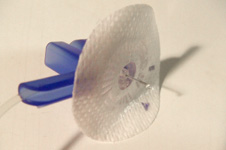An infusion set connects the insulin pump delivery device to your body. It works the same way as an intravenous line does. A needle is housed inside a cannula, a tiny plastic tube that is usually placed under the skin in the subcutaneous fat. This needle is necessary to puncture the skin to insert the set. After insertion, the needle is removed and the cannula remains in place.
For many sets, an “insertion device” is available. An insertion device is a push-button, spring-loaded tool that inserts the set. Many people feel it is easier and less intimidating to use than inserting it free hand. Specific insertion devices are available for specific infusion sets.
There are many types of infusion sets, but they can be categorized into two main groups – an “angled” set or “straight” set.
Angled sets are generally inserted at a 30-degree angle. They sit laterally under the skin. The cannula and needle are available in different lengths.
Straight sets are inserted perpendicularly at a 90-degree angle. The cannula is available in different lengths. Many sets come with an insertion device.
Infusion sets are an important part of successful pump therapy because they must provide constant insulin delivery. A crimped cannula, for example, can interrupt delivery and result in dangerously high blood sugars and ketone formation. (See Ketones and insulin pump therapy.)
Self-assessment Quiz
Self assessment quizzes are available for topics covered in this website. To find out how much you have learned about Insulin Pumps, take our self assessment quiz when you have completed this section. The quiz is multiple choice. Please choose the single best answer to each question. At the end of the quiz, your score will display. If your score is over 70% correct, you are doing very well. If your score is less than 70%, you can return to this section and review the information.
